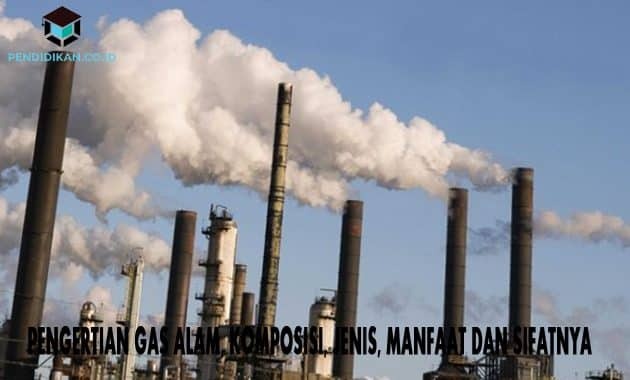Understanding Natural Gas, Composition, Types, Benefits and Properties Sifat
Education. Co. ID – At this time we will discuss about Natural Gas. Natural gas is very important in the continuity of life because natural gas is a source of energy. For more details below will be explained in more detail:

Definition of Natural Gas
Natural gas is a gaseous fossil fuel. Natural gas is a mixture of hydrocarbons that has great swelling power, high compressive strength, low specific gravity and naturally exists in the form of gas. Basically, the natural gas is collected underground with various compositions contained in the oil content (associated gas). All petroleum content is related to natural gas, where the gas dissolves in crude oil and also often forms a "gas cap" above the oil content. In addition, natural gas can also collect in coal mines and natural gas fields.
Natural Gas Composition
The main composition of natural gas is methane (80%), the rest is ethane (7%), propane (6%), and butane (4%), isobotane, and the rest is pentane. Apart from these compositions, natural gas can also contain helium, nitrogen, carbon dioxide, as well as other carbons. Natural gas is odorless, however, to detect a leak, an unpleasant-smelling substance is added so that the leak is immediately detected. To facilitate transportation, the natural gas is liquefied so that it is called liquefied natural gas or LNG (Liquified Natural Gas).
Natural Gas Type
Below will be explained Types of Natural Gas quoted from Ministry of Energy and Mineral Resources, below is the explanation
Pipe gas Gas is natural gas that is directly flowed from the gas field after the purification process to be used as fuel or industrial raw materials.
LNG (liquefied natural gas) is methane gas with a composition of 90% methane (CH4) which is liquefied at atmospheric pressure and at a temperature of -163 degrees Celsius. Before the liquefaction process, the gas must undergo a purification process first to be able to remove unwanted compounds such as CO2, H2S, Hg, H2O and hydrocarbons weight.
From the process it will reduce the volume of the gas to be 600 times smaller. This shrinkage will make LNG easier to transport and in larger quantities. The LNG is transported by ships to LNG terminals and then stored in tanks with atmospheric pressure. After that LNG is converted back into gas and distributed through a transmission system.
LPG (liquefied petroleum gas) or also liquefied natural gas with the main components propane (C3H8) and butane (C4H10). According to the type, LPG is grouped into:
- propane LPG,
- LPG butane as well
- Mixed LPG (mix) is a mixture of the two types of LPG above.
LPG can come from refining crude oil or from condensing natural gas in natural gas processing plants.
CNG (compressed natural gas) is natural gas compressed at high pressure so that its volume becomes about 1/250 of the volume of natural gas at standard conditions. The purpose of compressing natural gas is to obtain more gas that can be transported per unit volume of the vessel. The compression pressure of this CNG can reach 250 bar at atmospheric temperatures. The composition of natural gas that will be sent to consumers via CNG must meet commercial gas specifications such as the maximum water content, CO2 and heavy hydrocarbons. In addition, gas storage at very high pressures requires strict limits on water content as well as heavy hydrocarbons to prevent condensation and also the formation of hydrate.
Benefits of Natural Gas
The benefits of this natural gas include the following:
- Natural Gas as Fuel for Vehicles
- Natural Gas as a Source of Power Generation
- Natural Gas for Environmental Health
- Natural Gas to Contribution to the World Economy
- Natural Gas Creates Millions of Jobs
- Natural Gas for Industry
- Natural Gas Increases the Country's Economic Potential
- Natural Gas as Heating and Cooling Material
- Natural Gas as a Household Energy Source
- Natural Gas Producing Steam Power Source Sumber
- Natural Gas for Weather Engineering
- Natural Gas for Processing Forest Products
- Natural Gas Increases Revenue
- Natural Gas as Substitute Energy
- Natural Gas also Supports the Advancement of Scientific and Technological Processes
Natural Gas Properties
This natural gas is a flammable energy source. Natural gas consists of hydrogen and carbon compounds. This makes natural gas an energy source that is clean and safe for daily use. Natural gas can be found in color or colorless properties.
The hydrocarbon structure in natural gas when it just comes out of the ground consists of methane, ethane, butane, propane, carbon dioxide, oil, nitrogen, sulfur, as well as various other types of impurities. The natural gas processing process then functions to be able to separate various types of impurities so that the natural gas consumed by humans is clean.
Gas treatment process
The natural gas processing is carried out by a special factory that handles energy issues. Natural gas that comes out in the form of energy that can be used by the community directly has clean properties so it will be very safe.
Thank you so much and thank you for reading about hopefully what is described above can be useful for you.
See AlsoDefinition of Professional Teachers, 16 Criteria, and Competencies According to Experts
See AlsoDefinition of Saga and Examples
See AlsoDefinition of Podsol Soil, Characteristics, Formed Process and Morphology
